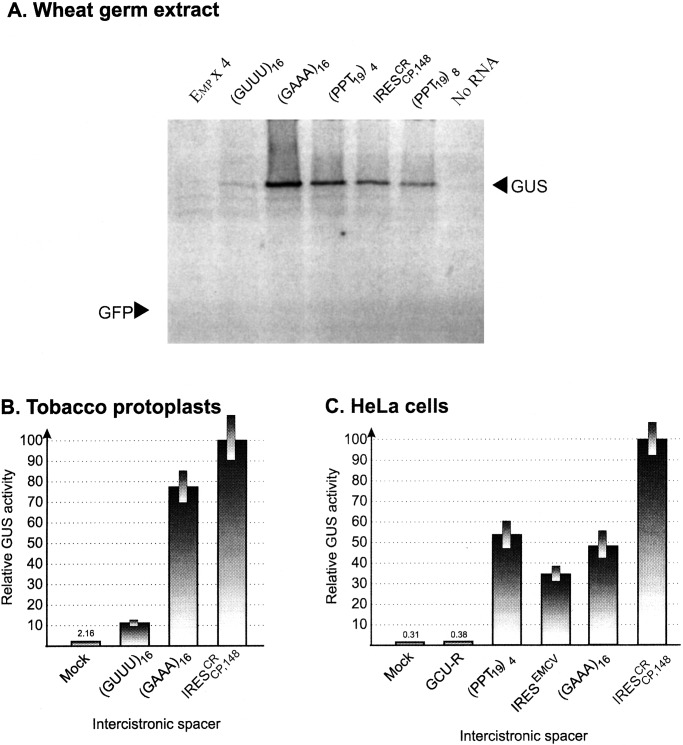Figure 4.
Comparative dicistronic analysis of IRES activities of multiple
G(A)3 modules and natural IRESs
(IRES and IRESEMCV) in WGE
(A), tobacco protoplasts (B), and HeLa
cells (C). Artificial sequences tested:
(i) (PPT19)4 and
(PPT19)8 representing the tandem repeats of
four (76-nt) and eight (152-nt) copies of the 19-nt AAAAGAAGGAAAAAGAAGG
sequence derived from PPT32 (see Fig. 3), respectively;
(ii) the 64-nt (GAAA)16 sequence consisting
of 16 G(A)3 elements; (iii) control U-rich
sequence (GUUU)16; (iv) the control Emp
× 4 sequence consisting of four copies of the U-rich
CGUUUGCUUUUUGUAGUA element derived from another crTMV IRES
(IRES
and IRESEMCV) in WGE
(A), tobacco protoplasts (B), and HeLa
cells (C). Artificial sequences tested:
(i) (PPT19)4 and
(PPT19)8 representing the tandem repeats of
four (76-nt) and eight (152-nt) copies of the 19-nt AAAAGAAGGAAAAAGAAGG
sequence derived from PPT32 (see Fig. 3), respectively;
(ii) the 64-nt (GAAA)16 sequence consisting
of 16 G(A)3 elements; (iii) control U-rich
sequence (GUUU)16; (iv) the control Emp
× 4 sequence consisting of four copies of the U-rich
CGUUUGCUUUUUGUAGUA element derived from another crTMV IRES
(IRES ) and (v) the GCU-rich
sequence (GCU-R) containing four copies of CGCGGGCG blocks linked via
the 7-nt sequence UUUGUUU used as an additional negative control.
(A) Analysis of proteins directed in WGE by dicistronic
H-GFP-ICS-GUS T7 transcripts containing artificial sequences as the
intercistronic spacer. Arrows indicate the position of GUS and GFP.
(B and C) GUS gene expression in tobacco
protoplasts (B) and HeLa (C) cells
transfected with dicistronic GFP-IRES-GUS constructs containing
different IRES sequences. “Mock” indicates that DNA-free solution
was used for transfection.
) and (v) the GCU-rich
sequence (GCU-R) containing four copies of CGCGGGCG blocks linked via
the 7-nt sequence UUUGUUU used as an additional negative control.
(A) Analysis of proteins directed in WGE by dicistronic
H-GFP-ICS-GUS T7 transcripts containing artificial sequences as the
intercistronic spacer. Arrows indicate the position of GUS and GFP.
(B and C) GUS gene expression in tobacco
protoplasts (B) and HeLa (C) cells
transfected with dicistronic GFP-IRES-GUS constructs containing
different IRES sequences. “Mock” indicates that DNA-free solution
was used for transfection.

